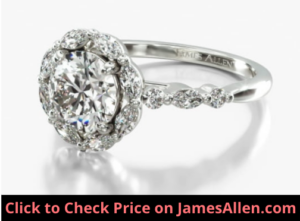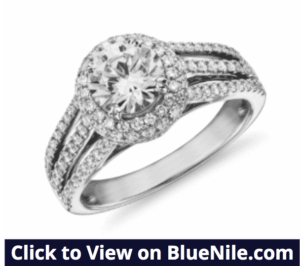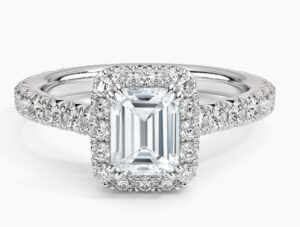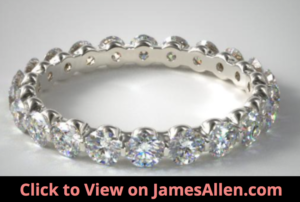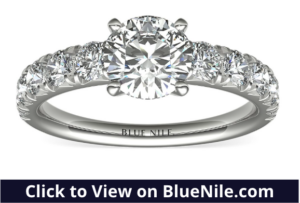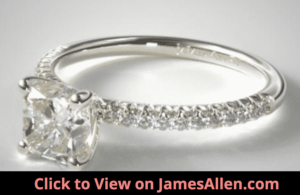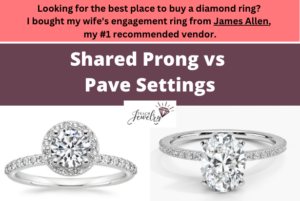
If you’re searching for a diamond ring, whether as an accessory or for an engagement ring, you’re likely focused on the main diamond.
But your choice of setting for the diamond shouldn’t be ignored. Two popular types of settings are shared prong and pave settings, and each creates a unique style for the ring.
The main difference between shared prong and pave settings is how the small diamonds are held on the ring. In a shared prong setting, a thin prong sits between diamonds to hold them in place. In pave settings, a small bead of metal is used to hold each gem.
We’ll explore shared prong versus pave settings, starting with an overview of each, six distinctions, and how to know which is right for you.
What are Shared Prong Settings?
Shared prong settings feature diamonds along the shank of the ring held together by metal prongs.
Adjacent diamonds share two thin prongs to minimize the amount of metal on the band.
Here’s an example with with a round cut at its center and marquise diamonds surrounding it, which you can rotate to view at every angle.
Even though the setting hides the metal as much as possible, the design better secures the diamonds than other types of settings.
It demonstrates how even within the same category, there are distinct styles.
Shared prongs are also designed to maximize the amount of light that can enter and exit the diamonds. There wouldn’t be the benefit of more diamonds along the shank if they were obscured by prongs.
Instead, the diamonds are placed tightly between the prongs, which rise to the point of the diamond’s table.
They don’t hang over and grasp the table like traditional prongs, so it remains fully exposed.
This is why many buyers who choose a step-cut as their center diamond opt for a setting like shared prongs. It allows the piece to compensate for the lack of brilliance displayed by an emerald or Asscher cut.
What are Pave Settings?
A pave setting includes small diamonds lining the shank. In some cases, the diamonds go halfway down, but in other instances, it encircles all of it.
View this high-resolution image of a stunning pave engagement ring setting in platinum to see an example of the former.
In most cases, the jeweler drills a small hole into the ring, where the pave diamonds sit. A small bead of metal is raised to surround each diamond and hold it in place.
Pave settings feature small diamonds, usually between 0.01 and 0.02 carats. For thin bands, such as knife edge rings, micro-pave diamonds can be added.
The benefit of the design is it adds more sparkle to the piece without detracting too much from the main diamond. It’s also less expensive than adding the same carat weight to the main diamond.
The pave diamonds don’t compete with the center one but instead add sparkle in more places.
The diamonds don’t have to be round cut. Diamonds in pave settings come in many shapes, such as princess, baguette, cushion, or emerald cuts.
Jewelers can set the prongs or metal beads in a way that can hold these unique shapes.
What are the Differences Between Shared Prong and Pave Settings?
1. Pave Settings Often Feature Multiple Rows
If you have a thick band, you can fit multiple rows of pave diamonds.
The traditional style includes one row of diamonds cascading down each side, but some designs are wide enough to fit three. The key is a combination of a thick shank and small diamonds.
A downside to this style is it can be uncomfortable to wear. Many buyers choose a thin band for its comfort.
Another disadvantage to this intricate design is depending on whether mini prongs or metal beads are chosen, additional diamonds means more metal.
The multiple rows of pave diamonds can call for dozens of metal prongs sticking out of the shank or dozens of beads placed closely together to secure them.
When the ring has a thick band and dozens of diamonds, it draws attention away from the center diamond. The reason many buyers opt against this type of setting is because they want the main gem to appear prominent instead of detracting from its appearance.
Shared prong settings often feature just one row of diamonds.
They’re larger than what you’ll find in a pave setting, so jewelers don’t try to fit multiple rows.
Additionally, the way the prongs are placed on the ring and hold the diamonds in place isn’t conducive to more than one line.
The result is a more simplistic design, where the diamonds on the ring add to its brilliance without distracting viewers from the main diamond.
2. Shared Prong Settings Use Metal Prongs to Hold the Diamonds
In almost every case, diamonds in a shared prong setting are held in place by metal prongs, while pave settings feature small metal beads.
When prongs are holding a center diamond, the thin tips latch onto its edges to hold it in place, whether in a v-shape, rounded, or flat-tab style.
In a shared prong setting, the prongs have a rounded top that resembles a sphere, and they don’t grab the diamond’s table in the same way.
Instead, its rounded edge sits on top to hold it in place.
They’re less susceptible to bending backwards and loosening the diamond, so this design avoids one of the main disadvantages of a traditional prong setting.
The way the diamonds are held in a pave setting is unlike either of those. Shared prongs are named after how multiple diamonds share two prongs, but pave diamonds are secured individually.
The small beads cover their girdle edges to lock them in place. In most cases, these beads aren’t apparent because the diamond sits on top. It creates the appearance of a continuous row of diamonds, as if the band itself were made of them.
3. Pave Diamonds can be on the Halo or Shank
Pave settings aren’t exclusive to the shank. They can also be placed around the center diamond to form a halo or double halo.
The metal band continues from the top of the shank to circle the diamond, and the pave-set diamonds go all the way around.
The accent gems make the main diamond appear larger because at a glance, they can be indistinguishable from it.
To add the most sparkle to your ring, set pave diamonds as a halo and on the shank. The ring will exhibit strong brilliance from top to bottom, with dozens of small diamonds to complement the bigger one.
It’s especially apparent when you twirl it around.
This design doesn’t work with a shared prong. The main diamond is already secured by multiple prongs, so jewelers wouldn’t place even more around it to hold the accents.
4. Shared Prong Settings Hold Larger Diamonds
If you want to maximize the size of the diamonds around the band, choose a shared prong setting.
The prongs are designed to hold larger diamonds in place in a way the metal beads in a pave setting cannot.
It results in a diamond ring with a higher total carat weight with fewer total diamonds.
Diamonds in a pave setting are often so small they blend together. For some buyers, this is on purpose. For others, you may want the diamonds on the shank to be distinguishable from each other.
Diamonds in a shared prong setting are often large enough that the naked eye can easily tell one from the other.
This doesn’t mean you have to find colorless gems with an excellent cut to avoid a dull appearance.
They’re still small enough that you shouldn’t pay a premium for the highest quality gems in the setting.
To the naked eye, they’ll look the same whether they’re colorless or near colorless or have a good or very good cut.
For example, the diamonds in this pave setting earned an H color grade, which is the fifth highest on the GIA scale and in the near colorless category.
But you can view the in high resolution, and you won’t spot any yellow.
Any inclusions often aren’t noticeable, so they can earn very slightly included (VS) clarity grades and often appear eye-clean. The one above has VS2 diamonds.
In fact, many of the diamonds you’ll find on the band have VS clarity and I or J color grades.
5. There are More Varieties of Pave Settings
If you’re looking for a setting with the most options, you’ll have plenty to choose from with all the types of pave settings.
Some of the most popular varieties include:
Micro pave: Micro pave patterns feature incredibly small gems fitted closely together. They have a carat weight of less than 0.01 carats. In some designs, more than 100 stones are placed on the band.
V-cut pave: This variation of a pave setting uses a v-cut to hold the diamonds. It often features stones circling all the way around. It’s known for its durability, which is an important factor in choosing a pave setting. The precise placement of each gem means repairs are difficult.
U-cut: U-cut designs, also called a scalloped pave, holds the gems in place with a distinct u-shaped cutout below. It’s one of the more expensive pave settings. Check out this example.
Petite pave: The petite pave setting opts for small prongs over metal beads. Jewelers design this setting in a way that minimizes the amount of metal sticking up, so light isn’t prevented from entering the diamonds.
French pave: French pave is also referred to as fish tail pave. Its goal is to minimize how much of the metal that holds the gems is visible. Small, V-shaped cutouts hold the diamonds flush to each other. It enhances the brilliance of the piece from every angle.
Shared prong settings don’t have the same number of varieties.
In fact, the standard design has no major alternatives.
The way to change the design involves the size and cut of the diamonds.
If you want a variation of the traditional round cut diamonds, the shared prongs can hold princess, cushion, or radiant cuts, in addition to many others.
These fancy shapes can act as complements to a round cut. For example, you might decide to pair a round cut with marquise diamonds on a shared prong setting.
They’re both brilliant and will ensure it maximizes light return.
6. Shared Prongs are Easier to Repair
If you wear a ring for long enough, you’ll likely deal with repairs in some form or another.
It’s most important to protect the main diamond and keep it in top shape. The diamonds forming a shared prong or pave setting can also fall out or get covered in dirt and debris.
A downside of pave settings is the difficulty of repairing them.
Creating the setting requires the precision of placing dozens of diamonds in close proximity to each other. If some fall out, putting them back requires extensive work from a professional jeweler.
Shared prongs have a similar problem, but the diamonds are larger and there are often fewer of them.
This means one or two falling out doesn’t cause the same issues as it does with pave settings, but it would still require a professional to repair them.
Is a Shared Prong or Pave Setting Right For Your Diamond Ring?
Shared prong and pave settings are two of the most common types for diamond and engagement rings.
Deciding on a shared prong versus pave setting involves understanding which qualities are most important to you.
Choose a shared prong setting in the following cases:
- You value securing the stones and don’t want the hassle of difficult repairs
- You only want one row of diamonds on the band
- You want to be able to identify each diamond on the setting instead of having them blend together to the naked eye
Consider a pave setting in these situations:
- You want multiple rows of diamonds either halfway or all around the shank
- You plan to circle the center diamond with a halo of accents
- You want to choose from the variety of designs within pave settings
Shared prong and pave settings are just two types among dozens, but by exploring how certain diamonds pair with those settings, you’re on your way to finding the right ring for you.
Jewelry Jargon Decoded: Prong and Pave Setting Q&A
Q1: Can you get a vintage look with either shared prong or pave settings?
A1: While both settings offer a modern aesthetic, pave settings, especially those with a micro pave or French pave design, are more often associated with a vintage or antique look due to their intricate design and the ability to incorporate milgrain detailing which is reminiscent of vintage jewelry.
Q2: How do shared prong and pave settings compare in terms of cleaning and maintenance?
A2: Shared prong settings are generally easier to clean and maintain due to the larger diamond sizes and fewer prongs, which allow for easier access to the spaces between the diamonds. On the other hand, pave settings, especially those with multiple rows of diamonds, may require more meticulous cleaning and maintenance to ensure that dirt and debris are thoroughly removed from the tighter spaces between the smaller diamonds and metal beads.
Q3: Can pave settings accommodate colored gemstones?
A3: Yes, pave settings can accommodate colored gemstones. However, the visibility and color of the gemstones may vary depending on the size and the type of pave setting used. It’s advisable to consult with a jeweler to understand how different gemstones would look in a pave setting.
Q4: Are there settings similar to shared prong and pave but with a different aesthetic?
A4: Yes, there are other settings like the bezel, channel, or tension settings that offer different aesthetics while also securely holding diamonds or gemstones in place. While shared prong and pave settings focus on maximizing the visibility and sparkle of the stones, other settings like bezel or channel settings offer a more streamlined or contemporary look with added protection for the stones.
Q5: What types of band designs work well with shared prong and pave settings?
A5: Shared prong settings work well with simpler band designs as they often feature one row of diamonds, allowing the focus to remain on the main diamond and the shared prongs. Pave settings, on the other hand, can be incorporated into a variety of band designs, from simple to intricate, due to the smaller size of the diamonds and the flexibility in arranging them on the band, including multiple rows or even around a halo.
Q6: What are the considerations for choosing the metal type in shared prong and pave settings?
A6: The choice of metal can affect the overall look and durability of the ring. For instance, white metals like platinum or white gold can enhance the sparkle of the diamonds in both shared prong and pave settings. However, platinum is more durable and less likely to wear over time compared to white gold, making it a more suitable choice for settings with delicate structures like pave settings.
Q7: How do shared prong and pave settings affect the overall cost of a ring?
A7: Shared prong settings usually involve larger diamonds which may increase the overall cost of the ring due to the higher total carat weight. Pave settings, on the other hand, utilize smaller diamonds which may be more cost-effective, but the intricate work required to set these tiny diamonds can also add to the labor cost, potentially impacting the overall price of the ring.

Jacob Clarke
Jacob Clarke is the founder of TeachJewelry.com.
He earned an Applied Jewelry Professional Diploma from the Gemological Institute of America (GIA) and now brings you essential information about diamonds, settings, and more.
Jacob has consulted with leading jewelry brands, and his work has been cited in Clean Origin, Diamond Nexus and industry publications.
He's also a member of the International Gem Society.
He enjoys discussing jewelry with readers, so contact him with any questions at jacob.clarke@teachjewelry.com.

